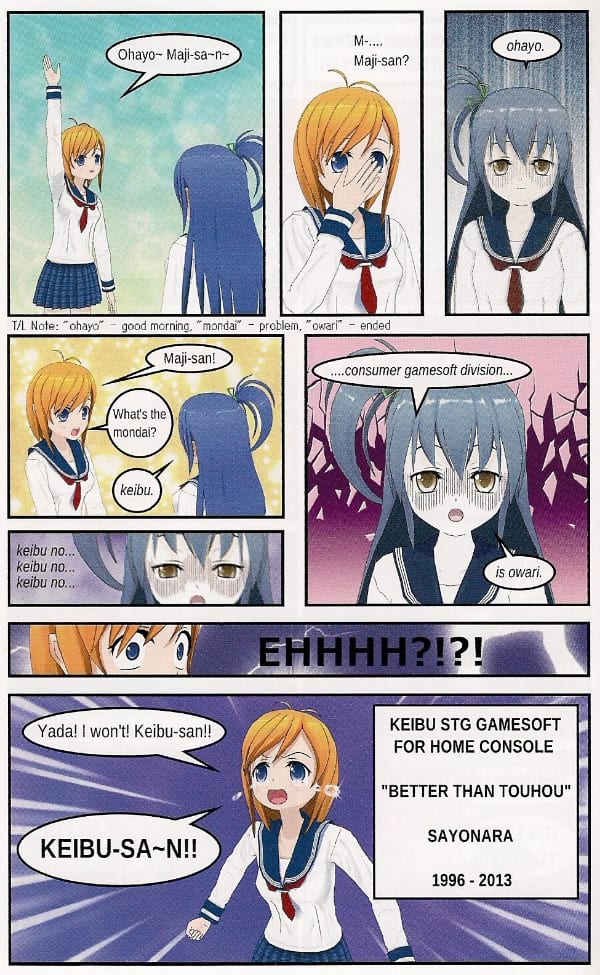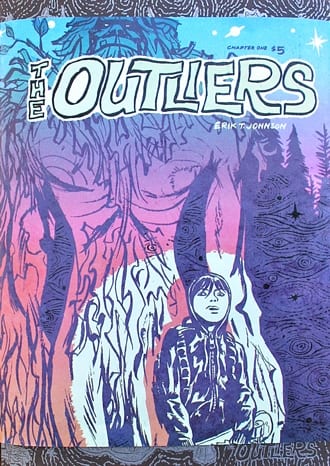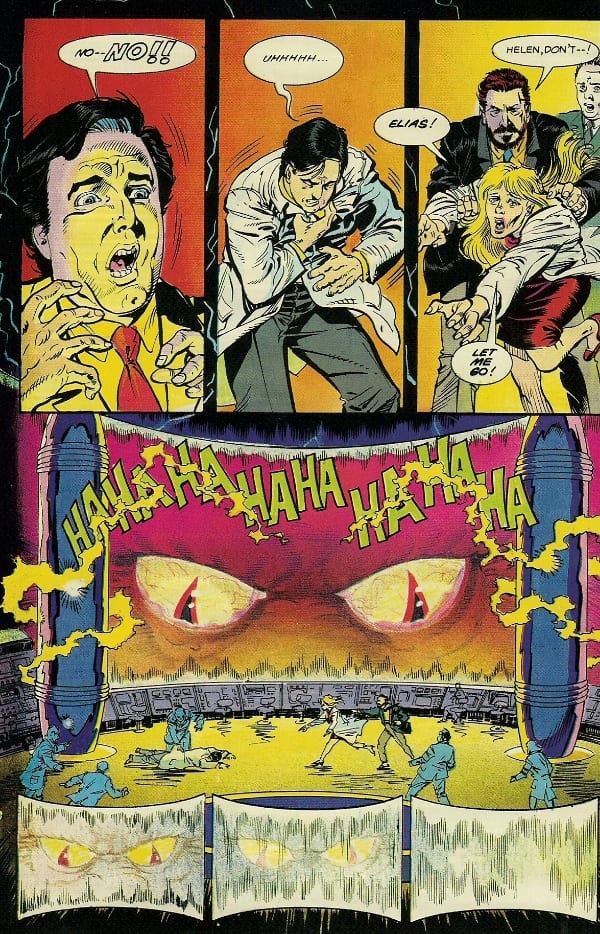 I knew I'd gone too far with last week's column when I arrived home the other night to find that somebody had replaced my desktop honor guard of Dark Ages Spawn adventure dolls with a trio of .38 cal semi-jacketed hollow points, positioned upright like tiny lead cigar tips atop a card reading "THREE KISSES FROM A JILTED LOVER" in Dan Nadel's handwriting. The message was clear: it's time to review a comic that somebody else in the United States of America could potentially access.
I knew I'd gone too far with last week's column when I arrived home the other night to find that somebody had replaced my desktop honor guard of Dark Ages Spawn adventure dolls with a trio of .38 cal semi-jacketed hollow points, positioned upright like tiny lead cigar tips atop a card reading "THREE KISSES FROM A JILTED LOVER" in Dan Nadel's handwriting. The message was clear: it's time to review a comic that somebody else in the United States of America could potentially access.
Hence, webcomics! I remain, as always, dreadfully bad at tracking the newest developments in original online funnies, though I do try and keep my eyes open for interesting Tumblr reblogs and the like. For example, I came across the comic to your left via David Brothers, who'd been posting samples without a lot of explanation. Initially, I'd thought it was some completely weird, awful Japanese production, but a little research gave up the true identity of the strip's author: longtime writer-on-anime David Cabrera, who'd planned a rightly cunning stunt with his Kawaiikochan Gaming No Korner, recently expanded into its very first print-on-demand physical package, the yet-more laboriously titled KAWAIIKOCHAN!! NO "This is Cool" ~GAMING NO MAGAZINE~.
I'm no expert on Japanese translation, but the (invented) term "Kawaiikochan" roughly approximates to "Lil' Cutie," with a feminine connotation. And through these cuties, Cabrera implicates two distinctly popular styles of comics that tend to go completely ignored by connoisseur sites such as the Journal. First there's the gaming webcomic -- still the 'zany husband gag strip' of the American online comics scene -- of the sort that made the likes of Jerry Holkins & Mike Krahulik into bona fide celebrity pundits. And then there's the yonkoma (or "4-coma"), a brand of vertically-oriented, four-panel humor manga found everywhere from dedicated magazines to in between longer serials in anthologies aimed at every demographic. Sometimes yonkoma feature continuing storylines, which break out of the four-panel system every so often to present 'full' comics - think Kiyohiko Azuma's Azumanga Daioh.
Best of all: Cabrera doesn't really draw the comic. It's composed entirely in ComiPo!, an elaborate clip art program with resources designed by animator Kumi Horii. A flawless victory of disrepute!
The trick is, Kawaiikochan isn't *actually* about cute girls having silly adventures or commentary on video game controversies du jour. It's about communication; specifically translation. The 'concept' of Kawaiikochan is that it's a Japanese gaming webcomic which has been 'translated' to English in the most cataclysmically self-defeating manner possible, ostensibly by some hapless otaku who's obsessed with authenticity to the point where -- despite the comic reading left-to-right, in Western format -- the language on the page becomes a hysteric jangle of half-comprehensible English cadence peppered with arbitrarily-selected Japanese terms explained in the panel gutters via T/L notes. To wit:
Yet while the common reaction to such a page will be along the lines of "what the fuck, this is giving me a headache," Cabrera is actually building a combo chain of various small jokes. First, there is the 'core' joke of Kawaiikochan: that the work's translation is impossibly unappealing. Beyond that basic quality, there is the use of the term "keibu," which seems inexplicable at first, until you realize the term is actually a overly-literal romanization of the Japanese game developer CAVE; never mind that the company itself employs the very simple English term "cave" as its own preference, because the true super-fan will always exhibit his or her mastery of linguistics with the utmost respect for the original text, a la the fan (pirate) translators who famously insisted on presenting the Death Note character "Light" as "Raito," in the face of all common sense. But don't worry - like a proper goof, the fictive localizer of Kawaiikochan isn't even consistent with the usage, so elsewhere in the comic the term "cave" is used anyway!
Moreover, it goes without saying that the reader is also expected to know: (1) what the somewhat obscure CAVE produces; (2) what an "STG" is; and (3) why a super-fan of STGs might prefer CAVE's wares to "Touhou." Once all of these achievements are unlocked, the reader might arrive at the secret, final joke: the fact that CAVE is probably not *really* shutting down its "consumer gamesoft division" in any substantive way, though rumors did fly, due to... wait for it... dodgy translations of Japanese news.
This is all quite ingenious, and, admittedly, almost totally inaccessible to 99.9% of the population of the world, which perhaps makes Kawaiikochan an ideal product of the micro-targeted, niche-happy webcomics world (and also perhaps explains the high price of $10.00 for the print edition). Be honest: do that many *more* people probably understand the comics crit inside baseball of Simon Hanselmann's Truth Zone? Hell no, but the pleasure of webcomics is in the unique and instantaneous connections authors can make with their small bands of readers/fellow travellers; indeed, at the moment the online Kawaiikochan is focused on an Ask Me Anything-styled set of response comics, encouraging reader participation in a manner not totally unlike the origins of Andrew Hussie's online arch-phenomena Homestuck.
Why, there's even fan comics.
Specifically, 11 of the 36 pages of KAWAIIKOCHAN!! NO "This is Cool" ~GAMING NO MAGAZINE~ (counting the covers, inside and out) are occupied by creators other than Cabrera, which initially seems like a good enough idea. Certainly, animator "PersonaSama" -- seen above -- can actually draw, which instantly puts him above the strip's creator in most traditional qualitative evaluations.
But these fan comics lack the conceptual rigor of Cabrera's rickety originals. There are merely funny gaming adventures starring two girls who cannot speak proper English, and whoa, hang on! There's a pretty thin line separating Kawaiikochan from Breakfast at Tiffany's already, though to understand the distinction it's useful to delve a ways back into internet history.
You all remember All Your Base, right?
Truly, it was a watershed moment in 'ethnic' humor. Reliant upon the misbegotten translations of Japanese games prepared for Western delectation, All Your Base effectively severed the comedy of broken English from any performative reality of actual, speaking racial minorities: it was instead a travesty on international communications. Or, in other words, while the ethic, linguistic comedy of the early 20th century American newspaper strips stemmed from a diverse, urban milieu of frequent miscommunications between different nationalities struggling to co-exist in an enclosed setting (and all of the class-based struggle accordant to that), All Your Base foretold of a flattened, limitless world of communication, where the normalcy of a video game like Zero Wing in its native language would be presumed; the comedy came from the struggle of two languages, in essential parity, stretching to touch.
I mean, that was the ideal. The potential. Some folks just took it as haw haw, fucking Japanese, and query, I guess, as to whether a result like that was even worth the effort. But work like Cabrera's nonetheless pursue the same egalitarian goal, retaining a core of love and respect for foreign entertainments -- in fact, it doesn't take much in the way of deep reading to find Cabrera admitting in the pages of his comic to drawing inspiration from suuuper low-budget Japanese comedy like gdgd Fairies -- while snickering at the failures of certain well-meaning souls who attempt the bridge the gap between cultures. It's not cruel work, though. It imagines, instead -- alas! -- that we'd all like to be friends on the internet.
***
PLEASE NOTE: What follows is not a series of capsule reviews but an annotated selection of items listed by Diamond Comic Distributors for release to comic book retailers in North America on the particular Wednesday, or, in the event of a holiday or occurrence necessitating the close of UPS in a manner that would impact deliveries, Thursday, identified in the column title above. Not every listed item will necessarily arrive at every comic book retailer, in that some items may be delayed and ordered quantities will vary. I have in all likelihood not read any of the comics listed below, in that they are not yet released as of the writing of this column, nor will I necessarily read or purchase every item identified; THIS WEEK IN COMICS! reflects only what I find to be potentially interesting.
***
SPOTLIGHT PICKS!
Bluesy Lucy: The Existential Chronicles of a Thirtysomething: You know what else is deep as hell? The labyrinth of French comics artists published in English. For example, some of you might remember SelfMadeHero's publication of Kiki de Montparnasse a few years back. The artist on that was Catherine "Catel" Muller, who now returns via Humanoids with a 120-page slice-of-life release from 2000, created with writer Veronique Grisseaux. The duo would subsequently produce a trio of color albums under the banner title of Lucie, but this is the b&w original from Les Humanoïdes' Tohu Bohu line of L'Associationesque releases, overseen at one point (I think) by Dupuy & Berberian, whose work is very much aesthetically in synch with Muller's here. Preview; $24.95.
The Outliers #1: I am always up, down and all around for a crazy-deluxe shoot-for-the-moon alternative adventure comic, and this Erik T. Johnson production (the debut solo release from a practiced illustrator) boasts a partial dust jacket and multiple two-color shades in support of its story about a troubled young boy's friendship with a giant woodland monster. Faint reflections of artists as diverse as Mat Brinkman and Becky Cloonan in the visual style; worth a look. Preview; $5.00.
--
PLUS!
Anna and Froga: I Dunno, What Do You Want to Do?: I dunno! I guess I'll flip through this second Drawn and Quarterly hardcover album (7.75" x 9.875," 40 pages) of short all-ages just-hanging-out comics by French cartoonist Anouk Ricard, a very distinct and attractive stylist who'll be seeing a longer, adult-oriented comedy (Benson's Cuckoos) released by D&Q in 2014. Samples; $14.95.
Creepy Comics #13: Oh holy hell, it's Josh "The Furry Trap" Simmons writing a lil' mainstream horror, right here, for the lucky 13th installment of Dark Horse's revival of the old Warren magazine. I thought Crossed would get to him first. Simmons will be teamed with artist Dean Haspiel, while writer/artist Peter Bagge handles a separate small feature, among various other contributors; $4.99.
Sergio Aragonés Funnies #9: You can't call it regular anymore, but any appearance by Bongo's one-man anthology for the beloved humor cartoonist is worth noting; $3.50.
Mo and Jo: Fighting Together Forever (&) Zig and Wikki in Something Ate My Homework: The week's new crop of Toon Books releases for the youngs, both of them inexpensive softcover reissues of 2010 publications - Mo and Jo is a humorous superhero tale from two generations of alternative comics (writer Jay Lynch and artist Dean Haspiel), while Zig and Wikki pits aliens against Earth critters via print comics debutantes Nadja Spiegelman & Trade Loeffler. The two books are 6" x 9" and 40 pages in color; $4.99 (each).
Judge Dredd: The Complete Case Files Vol. 6: Being Simon & Schuster's latest North American-targeted edition of Rebellion's UK compilations (presently up to vol. 20) of chronological future police abuse from the pages of 2000 AD. It's 336 pages, roughly covering July of 1982 through June of 1983, wherein writers John Wagner & Alan Grant presided over mostly short stories, drawn largely by Carlos Ezquerra and Ron Smith, with added contributions by Steve Dillon and others. Douglas Wolk review (UK edition); $19.99.
Nexus Omnibus Vol. 3: This is your periodic reminder that you can now buy over 400 pages of big '80s Mike Baron/Steve Rude indie superhero comics for twenty-five bucks a pop (albeit at somewhat reduced 6" x 9" dimensions). Published by Dark Horse and collecting issues #26-39, with guest art by Mike Mignola, Rick Veitch, José Luis García-López, Butch Guice, Paul Smith and others. Preview; $24.99.
Battle Angel Alita: Last Order Omnibus Vol. 2: Yeah, not a ton of interesting manga out this week, so feel free to catch up on Yukito Kishiro's never-ending cyborg mega-epic, now available in these 600+ page bricks from Kodansha. I think this accounts for vols. 4-6 of 17 available in English, and 18 out in Japan; $19.99.
Dinosaurs Attack! #2 (of 5): I dunno, I really enjoyed the first issue of this IDW reprint/exhumation of a mostly-unpublished '90s comics adaptation for a bunch of gory 1988 Topps trading cards - it's got one of those slightly overexposed-looking filtered light-like color schemes I tend to associate with Barry Windsor-Smith (the colorist is uncredited, though I assume it's George Freeman, a prime player in comic book coloring shop Digital Chameleon who also serves as penciller Herb Trimpe's finisher on the project), which leads to sequences like this:
Also, its tendency to suddenly drop in painted art (by Earl Norem in issue #1) for moments of special emphasis is weirdly reminiscent of Hong Kong manhua. But anyway, this issue should have the dinosaurs eating a shitload of people and breaking stuff. Written by Gary Gerani; $3.99.
Berkeleyworks: The Art of Berkeley Breathed from Bloom County & Beyond: Speaking of art, here is IDW -- having already burned through the Breathed newspaper comics library -- with a 304-page landscape-format hardcover dedicated to the non-strip endeavors of the titular children's book author and illustrator, "showcas[ing] Breathed's work from his earliest efforts to him most recent endeavors," per the solicitation; $59.99.
American Comic Book Chronicles: The 1950s: Your potential book-on-comics of the week, in which looongtime writer-on-comics Bill Schelly presents his contribution to a multi-volume, multi-author TwoMorrows project aimed at documenting every decade of American comic book history. Reactions have been mixed ("It’s hard to shake the feeling that the main goal of American Comic Book Chronicles – or [the 1960-1964] volume of it at any rate – is to offer little more than a nostalgia trip for baby boomer fans."), though I suspect the '50s will prove uniquely well-suited to this sort of summary treatment, insofar as a multitude of genres continuously challenged one another for genuine popular supremacy across periods of great proliferation and extreme crisis. A 240-page hardcover, with many color illustrations. Preview; $40.95.
Curing the Postmodern Blues: Reading Grant Morrison's & Chris Weston's The Filth in the 21st Century: But if it's a no-doubt wordier book-on-comics you desire for the week, I would recommend this new Sequart publication of a Tom Shapira text focused on my personal favorite bit of Grant Morrison writing, a 2002-03 grotesque adventure serial which some people declared to be Morrison's personal Watchmen back in the day, though the work has since become more of a specialist's favorite, rhetorically buried under a landslide of higher-profile superhero output. Expect interviews with Morrison, penciller Chris Weston and inker Gary Erskine, plus exploration of the work's relationship "to Morrison’s The Invisibles, to the 1999 film The Matrix, and to the work of Alan Moore" across 186 pages; $12.99.
--
CONFLICT OF INTEREST RESERVOIR: Huge, huge week for Fantagraphics reprints, kicking off with The Children of Palomar, a 8.25" x 10.75", 108-page collection of Gilbert Hernandez's 2006-07 Ignatz series New Tales of Old Palomar, in which the author revisited the location and characters of some of his most beloved Love and Rockets stories; $22.99. Then we travel back in time for Gahan Wilson Sunday Comics, a 12" x 6.25" landscape-format hardcover packing in the entirety of the Playboy and National Lampoon cartoonist's 1974-76 attempt at selling a weekly assemblage of gags to America's newspapers; $29.99. And then we go back, back to the pre-Code comic book era with Fall Guy for Murder and Other Stories and Child of Tomorrow and Other Stories, two b&w packages of vintage EC stuff from writer/artists Johnny Craig (208 pages) and Al Feldstein (216 pages) respectively; $28.99 (each). AND THEN it's away to those golden shores of yore (i.e. classic newspaper strips) for Prince Valiant Vol. 7: 1949-1950, in which Hal Foster is once again shot from the printer's proofs at a tall 10.25" x 14"; $35.00. WOW, THESE ARE OLD COMICS!!












